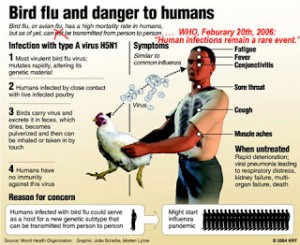There is a new strain of avian influenza that in the beginning was confined to transmission among birds only. However, with 8 deaths in humans reported in Asia by the end of January 2004 (7 children and one adult) there is a fear that the virus is possibly genetically adapting towards transmission between humans, which could cause a worldwide flu epidemic similar to the flu in 1918 where more than 40 million people died.
Presently the avian flu has killed a high percentage of chickens and ducks in Vietnam, China, Thailand, Indonesia, Pakistan, Cambodia, and Laos. Recently Japan, South Korea, and Taiwan have also been added to the countries where the avian flu has arrived in birds. The governments are busy killing chickens off by the millions in an attempt to stop transmission to man.
All of the human cases were found in people who lived close to chicken farms or who handled diseased chickens.
The virus strain has been characterized as the type A, H5N1 strain (= the H5N1 flu), of the avian influenza. This strain has surfaced in the past on two occasions. First, it hit 18 persons in Hong Kong in 1997 of which 8 persons died. With the help of strict isolation methods an epidemic was prevented. Secondly, in March of 2003 a father and son from Hong Kong had traveled to southern China and they returned sick with the flu. The father died, the son recovered. Disease investigation showed that the source of infection in all of these cases was contact with diseased birds or with live, infected poultry in open markets.
Unfortunately the present flu vaccines will not give protection against this strain. WHO officials had an emergency meeting at the end of January 2004 to discuss the strategy for preventing a worldwide epidemic with
this new influenza strain. Production of a new vaccine will take several months (up to 6 to 8 months), if it is done in the conventional way. The cheaper antiviral antibiotics such as amantadine and rimantadine that normally would cover an A type influenza are ineffective against this new flu strain. There are newer antiviral antibiotics, which are effective, but they are more expensive. With mass production they could become more affordable and this could interfere with the spread between humans, if the virus should adapt to this transmission behavior.
At the present time migratory birds that are infected with the flu virus are spreading the avian flu to birds in other neighboring countries. In the meantime farmers who are not satisfied with only a 10% reimbursement by their governments for forcefully killed chickens are selling chickens on open meat markets, some of which harbor the avian flu, and this is another possible mode of transmission. David A. Halvorson, a veterinary medicine doctor from the University of Minnesota in Saint Paul stated that the risk for avian flu in the US at the present time is low as the US is not importing any live poultry from Asia.
In an interview between Doug Kaufman from MD Consult and the CDC director Dr. Julie Gerberding on Jan. 29, 2004 it was learnt that 10 patients had died so far in Vietnam and Thailand. Six WHO scientist in Vietnam are working with officials to contain the avian flu in Asia so that it won’t migrate similar to another outbreak of the same type of avian flu strain in Hong Kong in 1997. It appears that the killing of chickens has made some difference. On the other hand the spreading of the disease among wild ducks is of some concern.
The CDC and WHO are working together on this and are pushing for accelerated production of live and of inactivated vaccines against avian flu. This is a type of vaccine, which would make it impossible for future avian flu strains to cross into human hosts. The mass production of antiviral drugs is also being pursued. Dr. Gerberding stated that oseltamivir (brand name: Tamiflu), one of the newer antiviral drugs, would be effective in treating this type of avian flu (cited in Medscape Medical News Jan. 29, 2004).
Dr. Neill, an infection specialist and professor of medicine at the Brown University School of Medicine in Providence, Rhode Island, said that in case of a future human breakout of an epidemic with this flu the following instructions should be followed: 1. cover your mouth and nose with paper tissue when you sneeze or cough 2. frequently wash your hands with soap and water 3. use designated containers for disposal of the used paper tissues 4. symptomatic patients should use face masks to prevent the spread of the flu.
This article is based on the Lancet (The Journal) Vol. 363, Vol. 9406 (Jan. 31, 2004), on news stories from MD Consult and on Medscape news stories.
More info about the Flu: http://nethealthbook.com/infectious-disease/respiratory-infections/flu/
Link to Centers for Disease Control and Prevention on avian (bird) flu
Last edited October 26, 2014






